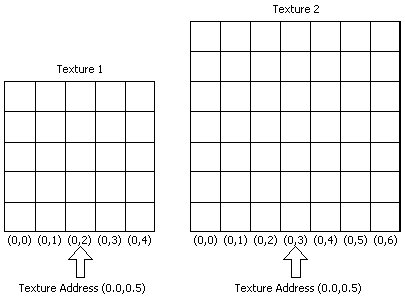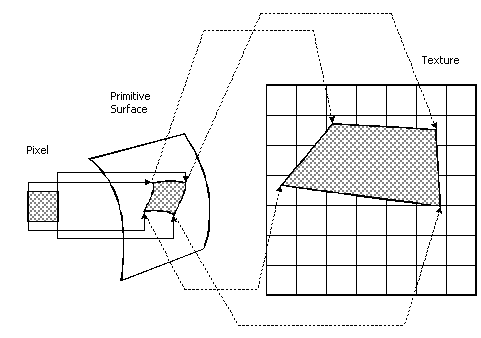
Textures, like most bitmaps, are a two dimensional array of color values. The individual color values are called texture elements, or texels. Each texel has a unique address in the texture. The address can be thought of as a column and row number, which are labeled U and V respectively.
Texture coordinates are in texture space. That is, they are relative to the location (0,0) in the texture. When a texture is applied to a primitive in 3-D space, its texel addresses must be mapped into object coordinates. They must then be translated into screen coordinates, or pixel locations.
Direct3D maps texels in texture space directly to pixels in screen space, skipping the intermediate step for greater efficiency. This mapping process is actually an inverse mapping. That is, for each pixel in screen space, the corresponding texel position in texture space is calculated. The texture color at or around that point is sampled. The sampling process is called texture filtering. For more information, see Texture Filtering.
Each texel in a texture can be specified by its texel coordinate. However, in order to map texels onto primitives, Direct3D requires a uniform address range for all texels in all textures. Therefore, it uses a generic addressing scheme in which all texel addresses are in the range of 0.0 to 1.0 inclusive. Direct3D programs specify texture coordinates in terms of U,V values, much like 2-D Cartesian coordinates are specified in terms of x,y coordinates.
A result of this is that identical texture addresses can map to different texel coordinates in different textures. In the following illustration, the texture address being used is (0.0,0.5). However, because the textures are different sizes, the texture address maps to different texels. Texture 1, on the left, is 5x5. The texture address (0.0,0.5) maps to texel (0,2). Texture 2, on the right, is 7x7. The texture address (0.0,0.5) maps to texel (0,3).

A simplified version of the texel mapping process is shown in the following diagram.

For this example, we are idealizing a pixel, shown at the left of the illustration, into a square of color. The addresses of the four corners of the pixel are mapped onto the 3-D primitive in object space. The shape of the pixel is often distorted because of the shape of the primitive in 3-D space and because of the viewing angle. The corners of the surface area on the primitive that correspond the corners of the pixel are then mapped into texture space. The mapping process distorts the pixel's shape again, which is common. The final color value of the pixel is computed from the texels in the region to which the pixel maps. You determine the method that Direct3D uses to arrive at the pixel color when you set the texture filtering method. For more information, see Texture Filtering.
Your application can assign texture coordinates directly to vertices. For details, see D3DVERTEX. This capability gives you control over which portion of a texture is mapped onto a primitive. For instance, suppose you create a rectangular primitive that is exactly the same size as the texture in the following illustration. In this example, you want your application to map the whole texture onto the whole wall. The texture coordinates your application would assign to the vertices of the primitive are (0.0,0.0), (1.0,0.0), (1.0,1.0), and (0.0,1.0).

Let's say you decide to decrease the height of the wall by one-half. You can either distort the texture to fit onto the smaller wall, or you can assign texture coordinates that will cause Direct3D to use the bottom half of the texture.
If you decide to distort or scale the texture to fit the smaller wall, the texture filtering method that you use will influence the quality of the image. For more information, see Texture Filtering.
If, instead, you decide to assign texture coordinates to make Direct3D use the bottom half of the texture for the smaller wall, the texture coordinates your application would assign to the vertices of the primitive in this example are (0.0,0.0), (1.0,0.0), (1.0,0.5), and (0.0,0.5). Direct3D will apply the bottom half of the texture to the wall.
It is possible for texture coordinates of a vertex to be greater than 1.0. When you assign texture coordinates to a vertex that are not in the range of 0.0 to 1.0 inclusive, you should also set the texture addressing mode. For further information, see Texture Addressing Modes.